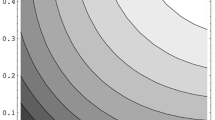Abstract
Cell suppression is a widely used statistical disclosure control method for tabular data. Commonly, several linked tables are suppressed simultaneously. After publication, additional tables may be requested. In many contexts, new tables mean new ways of grouping and aggregating data that has already been published. The suppression of the new tables must be coordinated with the tables that have already been disseminated. A certain type of synthetic decimal numbers has proven to be very useful for this purpose. Based on the aggregation of these decimal numbers, one can decide whether a cell should be suppressed or not. An aggregation summing up to a whole number means the same as non-suppression. This article describes the theoretical basis for such decimal numbers. This is based on standard methodology from ordinary linear regression. The method is illustrated by a small example. In addition, two practical applications at Statistics Norway are presented, where one involves large hierarchical and linked tables where more than 50000 unique cells were primarily suppressed.
Access this chapter
Tax calculation will be finalised at checkout
Purchases are for personal use only
Similar content being viewed by others
References
Bates, D., R Development Core Team: Comparing Least Squares Calculations (2022). https://cran.r-project.org/package=Matrix (r Vignette)
Burridge, J.: Information preserving statistical obfuscation. Stat. Comput. 13(4), 321–327 (2003). https://doi.org/10.1023/A:1025658621216
Castro, J., Via, A.: Revisiting interval protection, a.k.a. partial cell suppression, for tabular data. In: Domingo-Ferrer, J., Pejić-Bach, M. (eds.) PSD 2016. LNCS, vol. 9867, pp. 3–14. Springer, Cham (2016). https://doi.org/10.1007/978-3-319-45381-1_1
Chan, T.F.: Rank revealing QR factorizations. Linear Alg. Appl. 88, 67–82 (1987). https://doi.org/10.1016/0024-3795(87)90103-0
Fischetti, M., Salazar, J.J.: Solving the cell suppression problem on tabular data with linear constraints. Manag. Sci. 47(7), 1008–1027 (2001). http://www.jstor.org/stable/822485
Giessing, S., de Wolf, P.P., Reiffert, M., Geyer, F.: Considerations to deal with the frozen cell problem in Tau-Argus Modular. In: Joint UNECE/Eurostat Expert Meeting on Statistical Data Confidentiality, 1–3 December 2021, Poznań, Poland (2021)
Hundepool, A., et al.: Statistical Disclosure Control. John Wiley & Sons, Ltd., Boca Raton (2012). https://doi.org/10.1002/9781118348239.ch1
Langsrud, Ø.: Information preserving regression-based tools for statistical disclosure control. Statist. Comput. 29(5), 965–976 (2019). https://doi.org/10.1007/s11222-018-9848-9
Langsrud, Ø.: easySdcTable: Easy Interface to the Statistical Disclosure Control Package ’sdcTable’ Extended with the ’GaussSuppression’ Method (2022). https://CRAN.R-project.org/package=easySdcTable (r package version 1.0.3)
Langsrud, Ø., Lupp, D.: GaussSuppression: Tabular Data Suppression using Gaussian Elimination (2022). https://CRAN.R-project.org/package=GaussSuppression (r package version 0.4.0)
Lupp, D.P., Langsrud, Ø.: Suppression of directly-disclosive cells in frequency tables. In: Joint UNECE/Eurostat Expert Meeting on Statistical Data Confidentiality, 1–3 December 2021, Poznań, Poland (2021)
Author information
Authors and Affiliations
Corresponding author
Editor information
Editors and Affiliations
Rights and permissions
Copyright information
© 2022 Springer Nature Switzerland AG
About this paper
Cite this paper
Langsrud, Ø., Bøvelstad, H.M. (2022). Synthetic Decimal Numbers as a Flexible Tool for Suppression of Post-published Tabular Data. In: Domingo-Ferrer, J., Laurent, M. (eds) Privacy in Statistical Databases. PSD 2022. Lecture Notes in Computer Science, vol 13463. Springer, Cham. https://doi.org/10.1007/978-3-031-13945-1_8
Download citation
DOI: https://doi.org/10.1007/978-3-031-13945-1_8
Published:
Publisher Name: Springer, Cham
Print ISBN: 978-3-031-13944-4
Online ISBN: 978-3-031-13945-1
eBook Packages: Computer ScienceComputer Science (R0)




